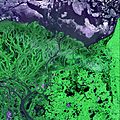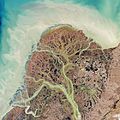Yukon–Kuskokwim Delta facts for kids
The Yukon–Kuskokwim Delta is a river delta located where the Yukon and Kuskokwim rivers empty into the Bering Sea on the west coast of the U.S. state of Alaska. At approximately 129,500 square kilometers (50,000 sq mi) in size, it is one of the largest deltas in the world. It is larger than the Mississippi River Delta (which varies between 32,400 and 122,000 square kilometers (12,500 and 47,100 sq mi)), and comparable in size to the entire U.S. state of Louisiana (135,700 square kilometers (52,400 sq mi)). The delta, which consists mostly of tundra, is protected as part of the Yukon Delta National Wildlife Refuge.
The delta has approximately 25,000 residents. 85% of these are Alaska Natives: Yupik and Athabaskan people. The main population center and service hub is the city of Bethel, with an estimated population of around 6,219 (as of 2011). Bethel is surrounded by 49 smaller villages, with the largest villages consisting of over 1,000 people. Most residents live a traditional subsistence lifestyle of hunting, fishing, and gathering. More than 30 percent have cash incomes well below the federal poverty threshold.
The area has virtually no roads; travel is by Bush plane, or by river boats in summer and snowmachines in winter.
Bethel is the location of the Yukon Kuskokwim Correctional Center.





